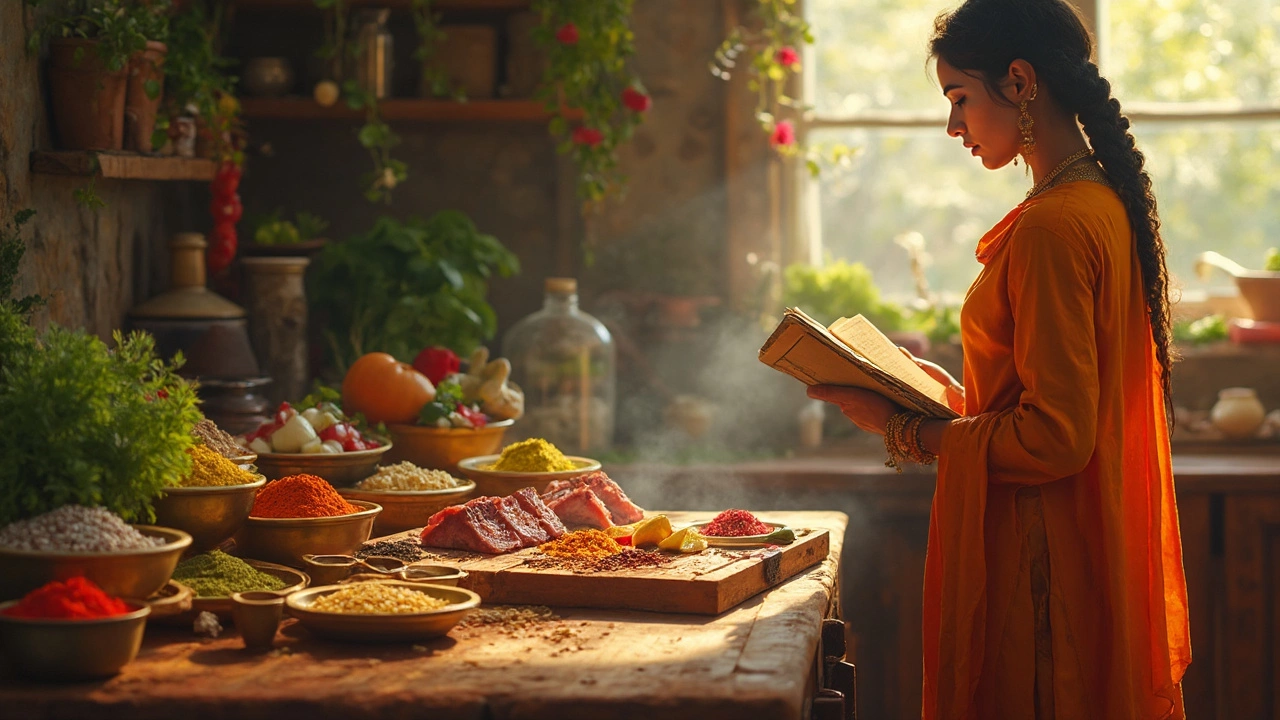Most people think Ayurveda is strictly vegetarian. That’s not exactly true. Dig through the old ayurvedic texts, and you’ll see meat shows up way more than you’d expect. The big idea in Ayurveda isn’t about banning one food group or another—it’s all about balancing what you eat to match your body type, season, and what’s going on with your health.
If you’re wondering, “Can I eat meat if I follow Ayurveda?” the answer is: it depends. Some folks thrive on lentils and veggies, but others might actually feel stronger or recover better from sickness with a bit of well-prepared meat in their diet. Ayurveda treats food more like medicine than just something to fill you up. It’s all about picking what helps you feel your best, not sticking to a rigid rulebook.
- The basics: Ayurveda’s approach to food and health
- What do classic Ayurvedic texts say about meat?
- Meat and your dosha: Does it fit your type?
- Situations where Ayurveda suggests meat is helpful
- Is vegetarian always better? Clearing up common myths
- Tips for making food choices that fit your lifestyle
The basics: Ayurveda’s approach to food and health
Ayurveda treats food as a tool for balancing your body and mind, not just as fuel or calories. The idea is pretty simple: what you eat affects how you feel, think, and even how you heal. Instead of fixating on calories, Ayurveda zooms in on qualities like hot or cold, heavy or light, oily or dry, and how these play with your body type—your dosha (Vata, Pitta, Kapha).
Everyone’s needs are different, so there’s no "Ayurvedic diet" that works for everyone. The system splits people into three main doshas, and what works for a Vata person might not suit a Kapha person at all. Some folks need more grounding foods, some need lighter fare, and others do best with cooling options. Your age, the season, even where you live—these all change what your body needs.
- Vata types are usually lighter, drier, quick-moving—think people who get cold easily.
- Pitta types tend to run hot, sharp, intense—they burn through food fast.
- Kapha types are sturdy, steady, and can gain weight more easily than the other types.
The main job of food is keeping your doshas in check. Too much of anything can tip the balance. Even healthy food, if it’s the wrong match, can throw your system off.
Here's a quick look at ways Ayurveda uses food:
- Food can act as daily maintenance, keeping you balanced day-to-day.
- Certain foods or recipes help you recover from illness or stress.
- What you eat changes as you age, or as the weather changes. In winter, you might need heavier, warmer foods. Summer? Go for lighter, cooling stuff.
Instead of focusing on what NOT to eat, Ayurveda puts more energy into finding the right foods for you at any given time. That’s why you’ll see different recommendations everywhere you look. If you check out the Charaka Samhita, a classic ayurvedic text, you’ll see foods—including meat—listed by their qualities and effects, not by categories like “good” or “bad.”
Ayurveda also pays attention to how you eat. You’re supposed to eat mindfully (without distractions), at regular times, and only when you’re actually hungry. Digestion is king in ayurvedic medicine. If your gut’s off, everything else is off too. One old saying nails it: "You’re not what you eat, you’re what you digest."
| Dosha | Best Food Qualities | Foods to Minimize |
|---|---|---|
| Vata | Warm, moist, oily, grounding | Dry, cold, raw, light |
| Pitta | Cool, fresh, mildly spicy, sweet | Hot, oily, fried, very spicy |
| Kapha | Light, dry, warm, astringent | Heavy, oily, cold, sweet |
What do classic Ayurvedic texts say about meat?
It's surprising to most people, but the classic Ayurvedic texts like Charaka Samhita, Sushruta Samhita, and Ashtanga Hridayam talk a lot about meat. They don’t totally ban it—instead, they go into detail about what types of meat are good for which health conditions, and even how to prepare it.
Charaka Samhita, one of Ayurveda’s cornerstone books, actually lists many kinds of animal meats and describes their effects on the body. For example, goat meat is said to be nourishing and easy to digest, especially for people who are weak or recovering from illness. Fish, poultry, and even wild animals are mentioned, each with their own medicinal value. No, it's not a free-for-all—cows and certain other animals are exceptions because of cultural and ethical reasons.
Sushruta Samhita, which is kind of like Ayurveda’s surgery manual, also mentions meat soups and broths as boosters for strong health, energy, and recovery. Back then, meat wasn’t everyday food for most—it was more like a supplement, used when someone was underweight, extremely tired, or sick.
- Meat is usually recommended for certain health issues, like extreme weakness or after surgery.
- The texts give specific rules about sourcing, preparation, and portion size. Meat should always be fresh and cooked well.
- They warn that too much can make you sluggish or mess up digestion—balance is key.
Here’s a quick look at what different meats are mentioned for:
| Type of Meat | Ayurvedic Benefit |
|---|---|
| Goat | Easy to digest, builds strength |
| Chicken | Good for energy, mild on digestion |
| Fish | Great for building tissues |
| Wild game (like deer) | Used for stamina but harder to digest |
So, yes, meat has a clear spot in Ayurveda, but only when it fits the person’s needs. The texts always talk about using meat mindfully and for solid reasons, not just for taste. It’s less about the label and more about what your body actually needs.
Meat and your dosha: Does it fit your type?
In Ayurveda, everything circles back to your dosha—basically, your body type and how you handle food, stress, and the seasons. There are three doshas: Vata (think light, dry, always on the move), Pitta (fiery, intense, and sharp-minded), and Kapha (steady, cool, and easy-going). Not all foods are equal for all doshas, and that includes meat.
If you’re a Vata type, you might get cold, tired, or anxious pretty easily. Traditional texts say some meat, especially slow-cooked or stewed, helps ground you and brings strength. It adds warmth and moisture—just what vatas usually need.
Pitta types run hot, both physically and personality-wise. Spicy, acidic stuff gets these folks worked up. Heavy red meats (think beef and lamb) can sometimes push pittas toward feeling overheated or irritated. If a pitta eats meat, fish or chicken is “safer" because it’s lighter and less heating.
Kapha folks tend to be stocky and a bit sluggish. Heavy, oily foods—like red meat—can slow them down more and might add to feelings of heaviness. Ayurveda usually recommends kapha types eat less meat and stick with lighter options if they include it at all.
| Dosha | How meat is viewed | Recommended types |
|---|---|---|
| Vata | Helpful for nourishment and grounding | Chicken, turkey, well-cooked meats |
| Pitta | Can be too heating if overdone | Fish, chicken, avoid red meats |
| Kapha | Usually too heavy, may cause sluggishness | Lean white meats (rarely), more plant-based recommended |
Here’s a simple way to figure out if meat fits your type:
- Notice how you feel after a meal with meat—energized? Sluggish? Bloated?
- Pay attention to digestion. Ayurveda says heavy, greasy meats slow things down and can cause ama (that’s undigested gunk).
- Try lighter meats first if you’re curious, then check in with your energy and mood after eating.
The main takeaway: Ayurveda does not ban meat, but it cares how much, what kind, and who’s eating it. Knowing your dosha helps you decide if Ayurveda and meat can work together for you.

Situations where Ayurveda suggests meat is helpful
Ayurveda doesn’t treat meat as a daily food for everyone, but it’s not off-limits either. Classic ayurvedic texts like the Charaka Samhita and Sushruta Samhita actually mention meat as useful in specific situations, especially when someone’s body needs a boost. Here’s when meat can play a helpful role, according to these ancient sources and modern practitioners.
- Weakness and Recovery: If someone is really weak after a long illness, injury, or surgery, meat is often recommended to help rebuild strength. The old texts are surprisingly detailed about it. For example, they suggest meat soup for loss of strength, fatigue, or when someone’s tissues are depleted. This isn’t about giant steaks—it’s usually broths or lightly cooked meat that are easy to digest.
- Vata Imbalance: Ayurveda divides people into body types (doshas), and if someone has a strong Vata imbalance—feeling dry, cold, anxious, or scattered—meat, especially with some healthy fat, can be grounding and nourishing. Basically, if you’re feeling frail or losing weight and veggies aren’t cutting it, meat might help.
- Post-pregnancy: It's an old-school remedy to use meat broths for new moms, especially if they’re very tired or struggling to recover. It’s not about eating meat at every meal, but using it as ‘medicine’ when the body really needs it.
- High Physical Demand: For people doing very hard physical labor, shepherds, athletes, or folks in cold climates, Ayurveda sometimes okays meat for its dense nutrition and warming effect.
The Charaka Samhita even lists the types of meat and their supposed health effects, and some practitioners today still refer to these ideas. Here’s an easy look at what classic Ayurvedic texts say:
| Situation | Recommendation |
|---|---|
| After injury/illness | Meat soups for rebuilding strength |
| Severe weakness or underweight | Well-cooked, easy-to-digest meats |
| Cold weather or exhaustion | Meat for warmth and stamina |
| Vata imbalance (frail, anxious, thin) | Fatty meats or broths |
One thing to remember: Ayurveda almost never recommends meat as the first fix. Most of the time, it’s for people who’ve tried lighter foods but aren’t getting better, or when someone really needs something substantial. It’s the opposite of mindless meat eating—it’s about using meat with a purpose and paying attention to how Ayurveda sees the bigger picture.
Is vegetarian always better? Clearing up common myths
A lot of people assume that Ayurveda only promotes vegetarian diets. That’s just not accurate. The old ayurvedic texts—Charaka Samhita and Sushruta Samhita—talk about meat being used as food and medicine in plenty of situations. The key point? Ayurveda isn’t strict about anyone being vegetarian unless it’s right for their body type, health condition, or personal choice.
Some western fans of Ayurveda push the vegetarian angle hard, but classical ayurveda is more about matching food to need. For example, someone recovering from a long illness, especially with weakness or harsh winters, might do better with animal broth or even lean meats. Protein from animal foods is rich in amino acids that the body can use for healing and rebuilding.
If you look at ancient India, lots of communities ate meat—mainly based on geography, climate, and what was available. It wasn’t one-size-fits-all. These texts even mention which meats are easier to digest (like goat and certain birds) and which ones can be heavy or aggravate certain conditions (like beef for folks with sluggish digestion).
There’s this idea that vegetarians live longer, but the science is mixed. A study published in JAMA Internal Medicine (2013) found slightly lower death rates among vegetarians, but not by much—and most folks in the group still ate some animal products.
| Diet Type | Ayurvedic View | Main Benefits |
|---|---|---|
| Strict Vegetarian | Good for Pitta types, gentle on digestion | Lower inflammation, ethical choice |
| Occasional Meat | Helpful for Vata/Kapha with weakness | Strength, recovery, warmth |
| Heavy Meat | Usually discouraged, esp. for Pitta | Can cause heaviness, tox buildup |
Bottom line? Choosing meat or skipping it should depend on your individual needs, not trends. Notice how your energy, digestion, and mood react to different foods. If you want to eat meat, Ayurveda says to pick clean, fresh, well-cooked options, and not to overdo it. If vegetarian feels best, great—just make sure you’re getting enough protein and iron, especially if you’re active.
- Check your Ayurveda type (dosha) before deciding your diet.
- If you’re vegetarian, watch for possible B12 or iron gaps—maybe get blood work done now and then.
- If you eat meat, stick with simple, lighter options like chicken, goat, or fish, and avoid reheated or deli meats.
Tips for making food choices that fit your lifestyle
Picking what to eat isn’t about sticking to someone else’s plan—it's about what your body and daily life actually need. Ayurveda makes this practical by encouraging you to pay attention to your own signals. If your job has you on your feet all day or you’re recovering from being sick, you might notice your body needs a little more protein, which might include meat. If you have a chill job or lots of stress, lighter and simpler foods could help bring some balance.
The big thing is to notice how food makes you feel. Ayurveda talks a lot about "agni"—that's your digestive fire. If you eat chicken and feel good energy and steady digestion, that’s probably your body saying yes. But if you notice heaviness, brain fog, or stomach problems, that’s a sign to slow down on those foods.
- Ayurveda suggests eating based on your daily activity and your environment. Hot weather? Lighter fare works better. Cold or rainy months? Heavier foods, even meat, can support your system.
- Don’t eat out of habit or tradition alone. Keep track of your energy, sleep, and digestion after meals. A little food journaling can show patterns that are easy to miss.
- If you eat meat, Ayurveda recommends it’s fresh, cooked with warming spices (think ginger, black pepper, turmeric), and eaten in small, easy-to-digest portions.
- Balance your plate. If meat is on the menu, load up on veggies, spices, and a little healthy fat. It’s not an excuse to skip the greens.
- Try to eat your biggest meal when your digestion is strongest—usually around lunchtime.
Here's a quick comparison of how common foods fit different needs, according to both Ayurvedic wisdom and modern nutrition data:
| Food | Best For | Ayurvedic Angle | Modern Nutrition Fact |
|---|---|---|---|
| Lean chicken | Recovery, strength, cold seasons | Grounding, builds tissues when cooked with right spices | High protein, supports muscle repair |
| Lentils | Everyday energy, hot climates | Light, easy on digestion, supports balance | Good protein, high fiber |
| Fish | Mental fatigue, weak digestion | Easy to digest, nourishing but not heavy | Rich in omega-3s for brain health |
Bottom line: listen to your body, use a dash of wisdom from Ayurveda, and don’t be afraid to adjust as things in your life change. No food is always right or always wrong—it’s about timing, quantity, and context.

 What Is the Most Common Orthopedic Emergency? A Deep Dive into Fractures
What Is the Most Common Orthopedic Emergency? A Deep Dive into Fractures
 Understanding Trazodone: Is It a Narcotic?
Understanding Trazodone: Is It a Narcotic?
 How Age Affects Open-Heart Surgery: Is There a Cutoff?
How Age Affects Open-Heart Surgery: Is There a Cutoff?
 Biggest Health Concerns Facing Medical Tourists in Costa Rica
Biggest Health Concerns Facing Medical Tourists in Costa Rica
 Why Am I So Angry After Open-Heart Surgery?
Why Am I So Angry After Open-Heart Surgery?